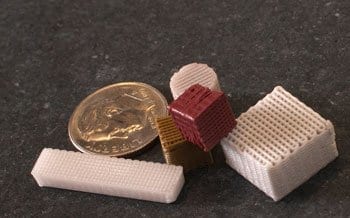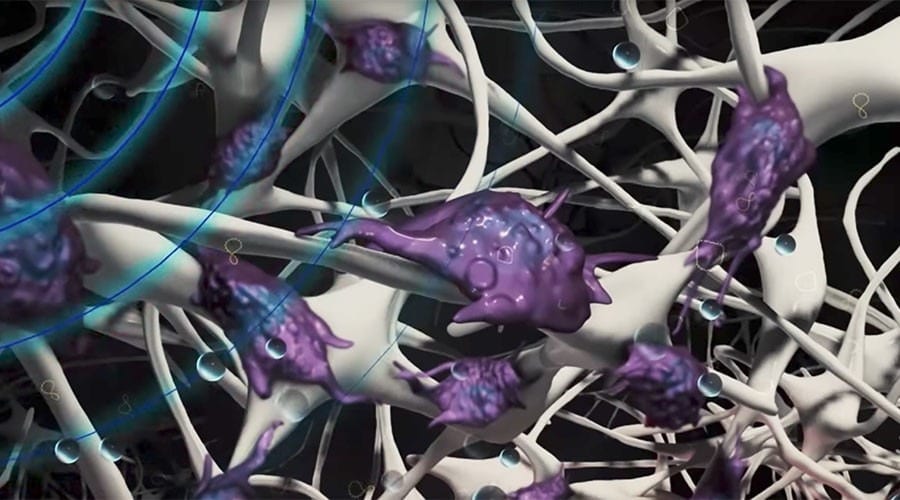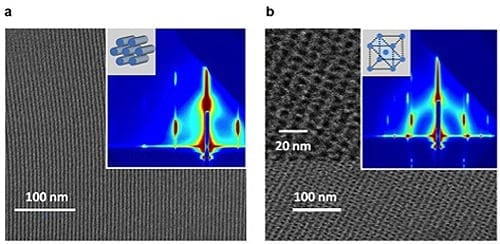
This marks the first time researchers have shown a glass implant strong enough to bear weight can also integrate with bone and promote bone growth
Researchers at Missouri University of Science and Technology have developed a type of glass implant that could one day be used to repair injured bones in the arms, legs and other areas of the body that are most subject to the stresses of weight.
This marks the first time researchers have shown a glass implant strong enough to bear weight can also integrate with bone and promote bone growth, says lead researcher Dr. Mohamed N. Rahaman, professor of materials science and engineering at Missouri S&T.
In previous work, the Missouri S&T researchers developed a glass implant strong enough to handle the weight and pressure of repetitive movement, such as walking or lifting. In their most recent study, published in the journal Acta Biomaterialia, the research team reported that the glass implant, in the form of a porous scaffolding, also integrates with bone and promotes bone growth.
This combination of strength and bone growth opens new possibilities for bone repair, says Rahaman, who also directs Missouri S&T’s Center for Biomedical Science and Engineering, where the research was conducted.
“Right now, there is no synthetic material that is practical for structural bone repair,” Rahaman says.
Conventional approaches to structural bone repair involve either the use of a porous metal, which does not reliably heal bone, or a bone allograft from a cadaver. Both approaches are costly and carry risks, Rahaman says. He thinks the type of glass implant developed in his center could provide a more feasible approach for repairing injured bones. The glass is bioactive, which means that it reacts when implanted in living tissue and convert to a bone-like material.
In their latest research, Rahaman and his colleagues implanted bioactive glass scaffolds into sections of the calvarial bones (skullcaps) of laboratory rats, then examined how well the glass integrated with the surrounding bone and how quickly new bone grew into the scaffold. The scaffolds are manufactured in Rahaman’s lab through a process known as robocasting – a computer-controlled technique to manufacture materials from ceramic slurries, layer by layer – to ensure uniform structure for the porous material.
In previous studies by the Missouri S&T researchers, porous scaffolds of the silicate glass, known as 13-93, were found to have the same strength properties as cortical bone. Cortical bones are those outer bones of the body that bear the most weight and undergo the most repetitive stress. They include the long bones of the arms and legs.
But what Rahaman and his colleagues didn’t know was how well the silicate 13-93 bioactive glass scaffolds would integrate with bone or how quickly bone would grow into the scaffolding.
“You can have the strongest material in the world, but it also must encourage bone growth in a reasonable amount of time,” says Rahaman. He considers three to six months to be a reasonable time frame for completely regenerating an injured bone into one strong enough to bear weight.
In their studies, the S&T researchers found that the bioactive glass scaffolds bonded quickly to bone and promoted a significant amount of new bone growth within six weeks.
The Latest Bing News on:
Glass implant
- Why Elon Musk's Neuralink brain implant reframes our ideas of self-identityon April 21, 2024 at 11:36 am
After living with paralysis for eight years, he had gained the ability to perform tasks previously inaccessible to him, thanks to a brain implant designed by Neuralink, a company founded by Elon Musk.
- Katie Price reveals ‘real reason’ she’s getting 17th boob job – and cruel warning from fanson April 19, 2024 at 12:24 pm
KATIE Price has revealed the truth behind why she wants to have a boob reduction. The former glamour model, 45, went under the knife for her 2120 CC implants last year in a bid to get the ...
- My dental implants caused brutal bruising and left me looking like a monsteron April 19, 2024 at 10:41 am
She’s revealing the ugly tooth about her beautiful new teeth. A Texas model says dental implants left her with bruising so bad that she looked like a human “Rorschach inkblot test.” ...
- Dental Implants Can Have a Huge Impacton April 19, 2024 at 1:57 am
He wasn’t shocked when the neighbor told him that he had received a smile makeover including dental implants. However, he was pleasantly surprised to hear that it was a local dentist that did ...
- We Finally Know Where Neuralink’s Brain Implant Trial Is Happeningon April 18, 2024 at 10:33 am
Elon Musk’s brain-implant company Neuralink has chosen the Barrow Neurological Institute in Phoenix, Arizona, as the initial study site to test its Telepathy device. The first participant in ...
- Vivasure implants first venous patient in PerQseal device trialon April 16, 2024 at 10:29 am
Vivasure Medical has treated the first venous patient in a clinical trial investigating its PerQseal Elite vascular closure system for large-bore vessel closure. Large-bore access is required for a ...
- Unlocking the Transformative Potential of Bioactive Glass in Healthcareon April 15, 2024 at 5:17 am
By Taha Khan Apr 16 2024 Reviewed by Lexie Corner Bioactive glass has become a significant modern healthcare innovation since its discovery by Larry Hench in the late 1960s. Among various compositions ...
- Stopping aspirin a month after stent implant may not increase blood clot riskon April 14, 2024 at 6:01 am
People who undergo percutaneous coronary interventions may be able to safely stop taking aspirin a month after without experiencing an increased risk of clots forming, a new study suggests.
- Contraceptive implant lodged in woman's lung for six years - and removing it could destroy arteryon April 8, 2024 at 7:01 am
A contraceptive implant has been lodged in woman's lung for six years - and it may leave her unable to have children again. Rebecca Hardy, 29, says she is "emotionally broken" having been told ...
- Neural implants face ethical hurdles, study findson April 6, 2024 at 5:00 pm
In a recent article published in the journal Scientific Reports, researchers conducted multiple focus group sessions with developers of artificial intelligence (AI)-driven neural implants.
The Latest Google Headlines on:
Glass implant
[google_news title=”” keyword=”glass implant” num_posts=”10″ blurb_length=”0″ show_thumb=”left”]
The Latest Bing News on:
Bone repair
- 11 Causes of Pain on the Outer Side of Your Footon April 27, 2024 at 3:54 am
Have outer foot pain? Here are common causes of pain on the outer side of your foot, the symptoms to watch for, and how to treat it.
- See how scientists uncover 50,000-year-old fossils from California's La Brea Tar Pits where saber-tooth cats and mammoths have been foundon April 27, 2024 at 3:06 am
La Brea tar pit scientists find mammoths, saber-tooth cats, dire wolves and more in asphalt. Here's how they've uncovered fossils for over 100 years.
- Stone cottage on sale for first time in 200 YEARS looks normal from outside – but hides a bone-chilling secret insideon April 26, 2024 at 6:48 am
A CREEPY COTTAGE has gone up for sale for the first time in two centuries – but there’s a skin-crawling catch. The three-bedroom detached seventeenth century home in Kidderminster is ...
- 5 Ways A Cat's Purr Is Said To Have 'Healing Powers' On Their Humanon April 25, 2024 at 1:15 pm
Petting your cat can increase serotonin and oxytocin, hormones that make us feel happy and calm. Hearing your cat purr also produces those hormones, which can help to lower your stress levels. So, ...
- Shoulder surgeons should rethink a common practice, new study suggestson April 25, 2024 at 11:58 am
A common practice of shoulder surgeons may be impairing the success of rotator cuff surgery, a new study from orthopedic scientists and biomedical engineers at Columbia University suggests. The work ...
- Bone Broth Drinks Can Heal Your Gut to Boost Weight Loss: Top Doc Shares 3 Recipeson April 25, 2024 at 11:17 am
The same thing has happened to bone broth… the food that is now being lauded as “liquid gold” for its ability to repair a damaged gut, speed weight loss and transform our health. Talk about an unsung ...
- New Way to Heal Broken Bones Faster May Also Make Them 3x Strongeron April 21, 2024 at 3:29 am
A new high-tech way of healing broken bones could take less time, and also make them over three times stronger.
- Bone Void Fillers Market Size, Share, Key Players, Revenue, Demand, and Forecast to 2024 to 2032on April 18, 2024 at 1:49 pm
Bone Void Fillers Market is valued at approximately USD 3.2 billion in 2021 and is anticipated to grow with a healthy growth rate of more than 8.5% over the forecast period 2022-2029. Bone Void ...
- Faster recovery: Irradiated plasma might help bones heal earlyon April 16, 2024 at 11:00 am
Irradiated plasma gives nonunion fractures a healing boost, which improves recovery time. Researchers treated a group of rats with a specific type of plasma called non-thermal atmospheric pressure ...
- Scientists develop maleic acid-treated bacterial cellulose gel for enhancing bone repairon April 15, 2024 at 1:48 pm
The field of bone tissue engineering (BTE) is a promising avenue for addressing bone injuries and defects by constructing artificial scaffolds with bionic functionalities. Due to its unique 3D network ...
The Latest Google Headlines on:
Bone repair
[google_news title=”” keyword=”bone repair” num_posts=”10″ blurb_length=”0″ show_thumb=”left”]











